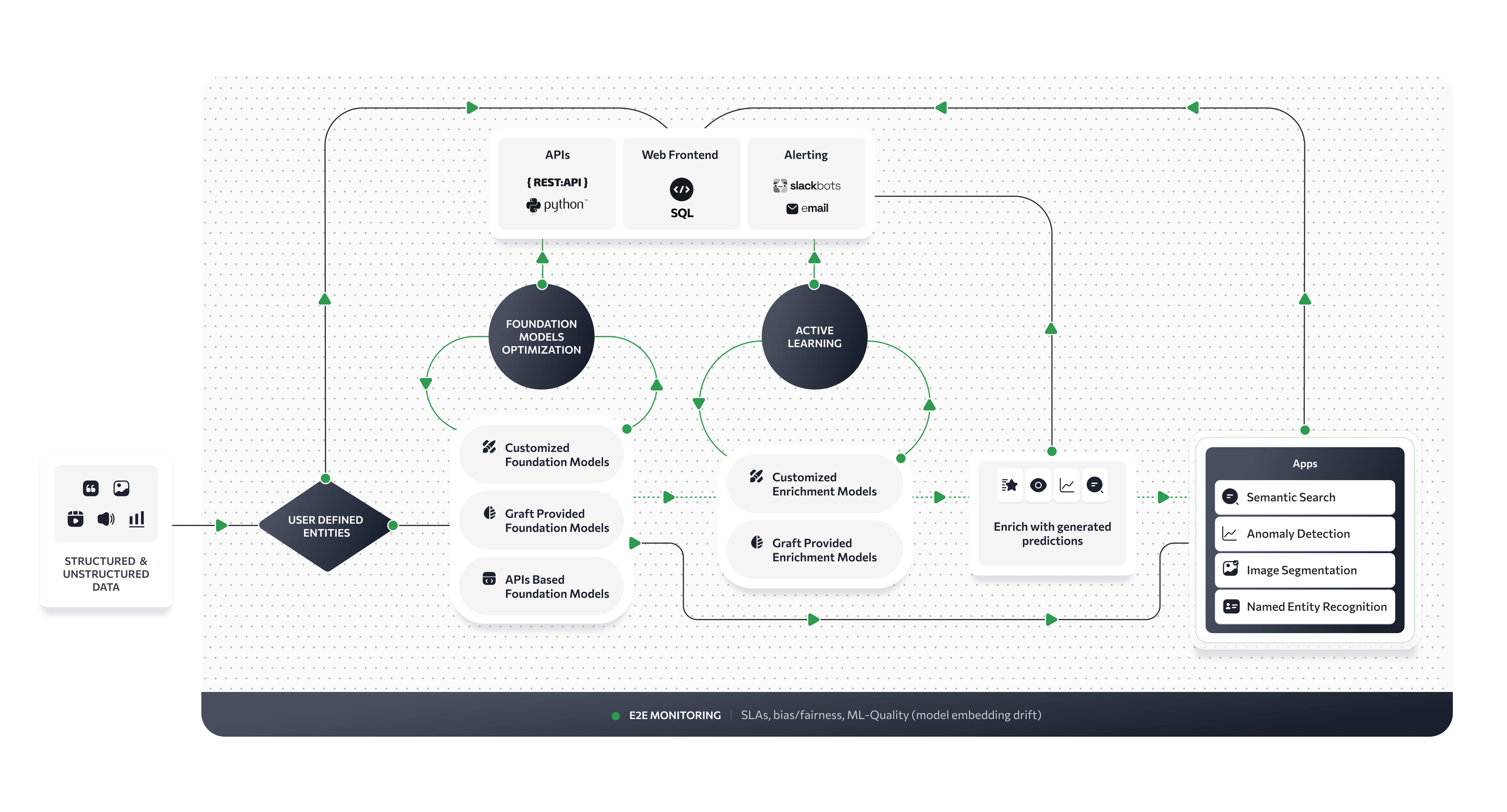
From the outside, the ascendance of foundation models and the ensuing Cambrian explosion of startups based around them must have seemed surprising and unpredictable. It wasn’t. Neither is the trajectory of the artificial intelligence (AI) industry as a whole. In this article, we’ll situate recent advances in AI within a broader context, a context that also allows us to look ahead toward the coming rise of what we call Modern AI.
The rise of Modern AI
When we started Graft two years ago, before the term ‘foundation model’ had been coined, it was grounded in the hypothesis that the industry was going to converge around the use of large, pretrained models. That convergence had been underway at the world’s top AI companies for many years. Companies like Google, Amazon, and Meta have been using these large models, and related technologies like embeddings, across every major use case, including search and recommendations, content moderation, customer analytics, and cybersecurity.
With that convergence in technologies being applied across use cases came a corresponding convergence in AI infrastructure. While tossing embeddings into a vector database for simple search applications may feel satisfying, it’s a far cry from a production system, which has numerous requirements around performance, reliability, compliance, quality, and cost. Achieving such properties requires the coordinated activities of a long list of components and services that span the lifecycle of a use case from data ingestion through optimization and monitoring.

We call the cohesive system formed by these constituent pieces a Modern AI Platform, of which Graft is the prime example. The platform has a number of properties—hallmarks of Modern AI—that reflect long-term trends in the industry.
- Foundation models. At the heart of Modern AI are large, pretrained models that are now commonly known as foundation models. Instead of starting from scratch, foundation models start you within spitting distance of a solution. That drastically reduces the data and labeling requirements, among other benefits. Customization of these models on proprietary data further advances the starting line. We’ll continue to see more of these models for different domains and modalities (more on this below), and the tools for building them will become increasingly accessible and ubiquitous.
- Data-centric. Classical machine learning (ML) involves feature engineering, model selection, hyperparameter tuning, and so on. These activities require specialized knowledge of the underlying ML machinery that most people do not possess. A data-centric approach instead shifts the focus to the data and use cases, where a user is more likely to have expertise and the ability to bring in relevant context. For example, a user looking to improve the quality of a model should be guided to provide feedback (like labeling examples) rather than fiddling with hyperparameters or model architectures. Most classical ML activities can and should be automated, freeing an organization to focus on the parts of AI that yield differentiating value.
- Full-lifecycle. While it has recently been fashionable to declare something end-to-end merely by defining those ends conveniently, a truly end-to-end platform begins at the source(s) of data and ends when a use case is retired (possibly years later). It remains connected to the data sources to maintain a real-time view of reality. Static data uploads, by contrast, yield static insights. A true end-to-end platform further hosts the resulting use cases, monitoring them, performing maintenance as required, and pulling humans into the loop where automation doesn’t suffice. As a result, there is no “path to production” problem, where feature engineering and other tricks used to make a solution work in development are difficult to translate to a production environment. Anything built on a Modern AI Platform is guaranteed to work in the production environment, because the platform is the production environment.
There are also a couple of trends that are still nascent but foreseeable:
- All the data. At the moment, the attention of the world is on large language models (LLMs). But nothing about foundation models is specific to text, and we will see a similar proliferation of models built on other modalities like images, audio, video, and more exotic modalities like graphs and geospatial data. Models will be built to support multiple modalities. We’re already seeing this trend emerge with image-generating models like DALL-E or Midjourney that touch both text and images.
- Universally accessible. You should not need to understand how machine learning algorithms and processes work in order to use the technology, any more than you should need to understand the mechanics of a car’s differential or the chemistry of a catalytic converter in order to drive a car. More than anything else, ChatGPT was a UX milestone. Customers increasingly expect to be able to interact with software the way they would interact with a person, using natural language, context, and other cues to convey intent and provide guidance.
Removing the barriers to AI adoption
Historically, there have been three major barriers to entry for organizations looking to adopt AI: data, infrastructure, and expertise. Taken together, Modern AI represents an opportunity, possibly for the first time in history, to remove all three barriers. Foundation models drastically reduce data and labeling requirements; full-lifecycle Modern AI platforms (like Graft) unify all of the infrastructure in a holistic package; and data-centricity, LLMs, and other UX advancements make all of the above accessible to an ever-widening community.
At Graft, we believe that Modern AI should exclude no one. Think of your favorite nonprofit or locally owned business. Chances are, they aren’t in the category of organizations historically served by vendors of AI technologies. Even at organizations traditionally viewed as being tech-savvy—or even ‘AI first’—there are really only a small number of people actually empowered to wield those technologies. Artificial intelligence is a tide that can lift all boats, and the world will be better for it.
Putting AI within reach of every person at every organization is an ambitious goal, but Graft can see the long arc of these technologies, and we believe they bend toward a world where no one is left behind.







